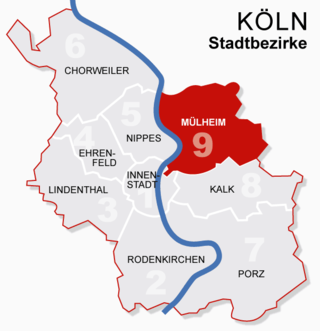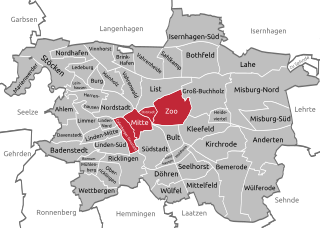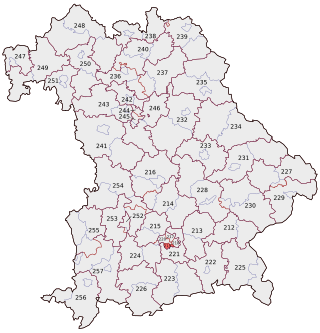
Munich is the capital and most populous city of the Free State of Bavaria. With a population of 1,558,395 inhabitants as of 31 July 2020, it is the third-largest city in Germany, after Berlin and Hamburg, and thus the largest which does not constitute its own state, as well as the 11th-largest city in the European Union. The city's metropolitan region is home to 6 million people.

Erftstadt is a town located about 20 km south-west of Cologne in the Rhein-Erft-Kreis, state of North Rhine-Westphalia, Germany. The name of the town derives from the river that flows through it, the Erft. The neighbouring towns are Brühl, Kerpen, Zülpich and Weilerswist.

Hörde is a Stadtbezirk and also a Stadtteil (Quarter) in the south of the city of Dortmund, in Germany.

Mülheim is a borough (Stadtbezirk) of Cologne in Germany and a formerly independent town. Mülheim is located on the right bank of the Rhine opposite the old town of Cologne.

Munich-Giesing station is a railway station in the district of Obergiesing in the Bavarian state capital of Munich and is a station of the Munich S-Bahn and the Munich U-Bahn. It is located on the Munich East–Deisenhofen railway, the Munich-Giesing–Kreuzstraße railway, which branches off to the east from the Munich East–Deisenhofen line next to the Perlacher Forst cemetery, and the second trunk line of the Munich U-Bahn. The station is served by about 280 S-Bahn services each day.

Stadelheim Prison, in Munich's Giesing district, is one of the largest prisons in Germany.

Au-Haidhausen is the 5th borough of the German city of Munich, Bavaria. It is formed by the Au and Haidhausen districts.

Au is a district in the south eastern plain tract of the German city of Munich in Bavaria. Au extends from the Deutsches Museum in the north and along the Isar up to Wittelsbacherbrücke in the south.

Trudering-Riem is the 15th borough (Stadtbezirk) of Munich, Bavaria, consisting of the quarters (Stadtteile) Trudering and Riem. This area is the former location of Munich's old airport, Riem Airport.

Untergiesing-Harlaching is the 18th borough of Munich, Germany, mostly the districts of Untergiesing and Harlaching. The borough's western border is the river Isar, in the south it borders on Grünwald and the Perlacher Forst [German-language Wiki: Perlacher Forst], to the north-west on the Munich borough of Obergiesing and to the north on the borough of Au-Haidhausen.

Haidhausen is a quarter of Munich, Germany. It is now part of the borough—or stadtbezirk—number 5 Au-Haidhausen.

Neuhausen and Nymphenburg are boroughs of Munich, the capital of the German state of Bavaria. They had been merged into the borough 09 - Neuhausen-Nymphenburg in 1992. For further information on the Munich boroughs, see: Boroughs of Munich.

Mitte is the first borough of Hanover, the state capital of Lower Saxony. As of 2020, it has 36,645 inhabitants and consists of the quarters Mitte, Calenberger Neustadt, Oststadt and Zoo. The district mayor is Cornelia Kupsch (CDU).

The Ostfriedhof in Munich, situated in the district of Obergiesing, was established in 1821 and is still in use. It contains an area of more than 30 hectares and approximately 34,700 burial plots.

Kessenich is a district of the former German capital city Bonn. It is best known for the German confectionery company Haribo.

Munich South is an electoral constituency represented in the Bundestag. It elects one member via first-past-the-post voting. Under the current constituency numbering system, it is designated as constituency 219. It is located in southern Bavaria, comprising the southern part of the city of Munich.

Plieningen is the southernmost borough (Stadtbezirk) of Stuttgart in the state of Baden-Württemberg. Plieningen is located about 10 kilometres (6.2 mi) from the city center of Stuttgart on the Filder Plain. Schloss Hohenheim, part of the Stuttgart Airport, and the parking garage for the Stuttgart Trade Fair are located here.

Ramersdorf-Perlach is a borough of Munich. It is located south-east of the city center and is the most populous of Munich's boroughs with a population of about 116,000. It consists of the five districts Ramersdorf, Balanstraße West, Altperlach, Neuperlach and Waldperlach.
The Balanstraße is a street in Munich which begins at the Rosenheimer Platz and runs in a southerly direction through the districts Haidhausen, Giesing and Ramersdorf to the district of Fasangarten. It ends at the border road directly on the city boundary to the municipality Neubiberg in the district of Munich.



















